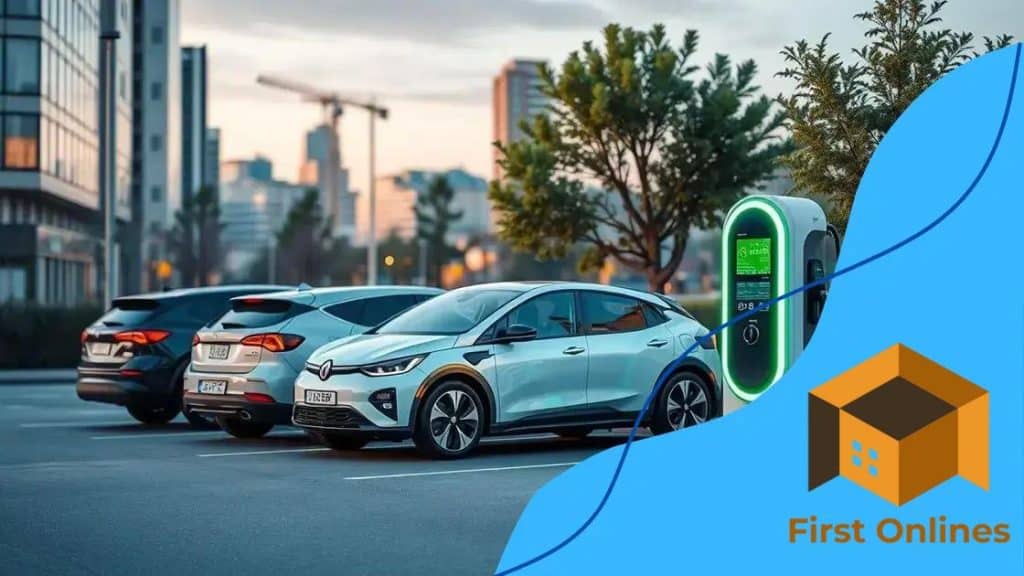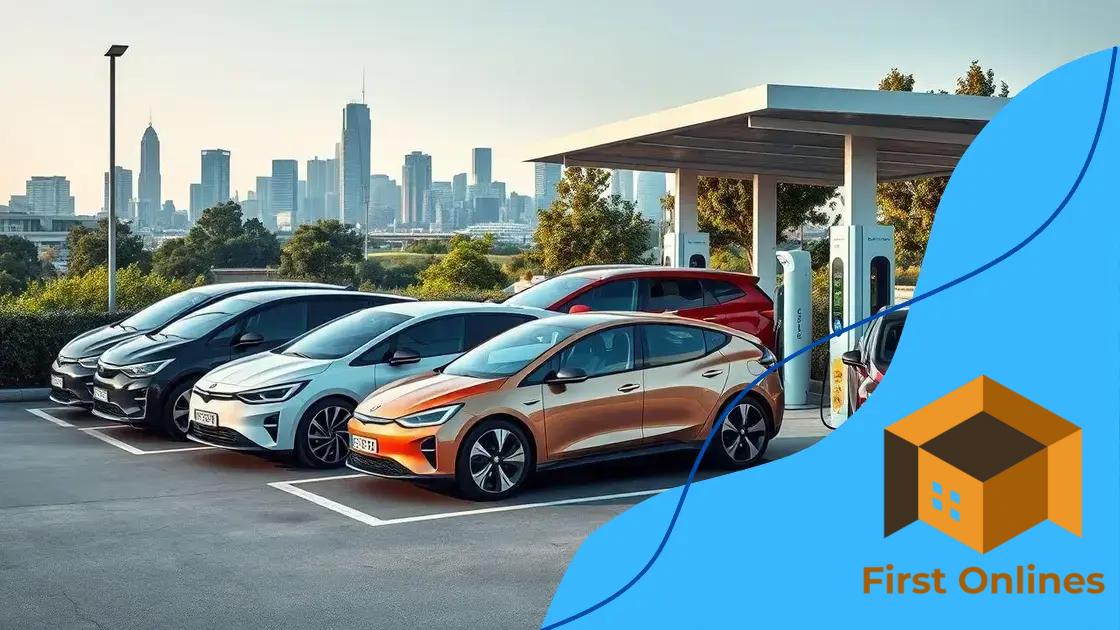The rise of electric vehicles and their impact on transportation

Anúncios
The rise of electric vehicles is transforming transportation by offering eco-friendly alternatives, advancing technology, and increasing sustainability, supported by government incentives and expanding charging infrastructure.
The rise of electric vehicles and their impact on transportation is more than just a trend—it’s reshaping how we think about mobility. Have you ever considered how this shift could affect your daily commute? Let’s dive in.
Anúncios
Understanding electric vehicles
Understanding electric vehicles is essential in today’s rapidly changing world. As traditional fuel sources deplete, electric vehicles (EVs) are emerging as a cleaner alternative for transportation. They play a vital role in reducing our carbon footprint.
What Are Electric Vehicles?
Electric vehicles are powered entirely or partially by electricity instead of gasoline or diesel. This means that they produce fewer emissions and offer a more sustainable option. EVs use various technologies, including:
- Battery Electric Vehicles (BEVs)
- Plug-in Hybrid Electric Vehicles (PHEVs)
- Fuel Cell Electric Vehicles (FCEVs)
Each of these types has its own unique advantages. For instance, BEVs run solely on electric power, making them ideal for short commutes. In contrast, PHEVs combine combustion engines with electric propulsion, providing flexibility.
Anúncios
How Do Electric Vehicles Work?
Electric vehicles are equipped with electric motors that draw power from rechargeable batteries. When you charge an EV, you replenish its battery, which powers the motor. This process significantly differs from traditional vehicles that rely on combustion engines. The technology behind EVs has advanced significantly, leading to longer ranges and faster charging times.
Furthermore, EVs are not just environmentally friendly; they also offer significant savings over time. Owners benefit from lower fueling costs and reduced maintenance expenses since electric motors have fewer moving parts than their gasoline counterparts.
In addition, advancements in charging infrastructure are making it easier to own an electric vehicle. Public charging stations are rapidly increasing, enabling drivers to charge their vehicles conveniently.
Overall, understanding electric vehicles involves looking at their technology, benefits, and how they can fit into our future. They represent a significant leap towards sustainable transportation by helping to combat climate change.
Environmental benefits of electric vehicles
The environmental benefits of electric vehicles (EVs) are significant and contribute to a healthier planet. These vehicles are designed to reduce harmful emissions and enhance air quality. With electric vehicles, we can take a substantial step towards sustainability.
Reduced Greenhouse Gas Emissions
One of the most notable advantages of electric vehicles is their potential to lower greenhouse gas emissions. Unlike traditional gasoline vehicles, EVs produce zero direct emissions during operation. This change contributes to cleaner air and a reduction in global warming.
- EVs help decrease the carbon footprint.
- Using renewable energy sources for charging can further lower emissions.
- Public health improves with less pollution in urban areas.
As cities adopt more electric vehicles, the overall air quality can be expected to improve rapidly.
Efficient Energy Use
Electric vehicles utilize energy more efficiently compared to their gasoline counterparts. While internal combustion engines convert only about 20% of gasoline into movement, electric motors convert over 60% of electrical energy from the grid to drive the wheels.
This high efficiency means that less energy is wasted, resulting in lower energy consumption overall. Additionally, as the electricity grid shifts to incorporate more renewable sources such as solar and wind power, the environmental impact of charging electric vehicles continues to decrease.
Adopting electric vehicles can also significantly reduce noise pollution. EVs operate more quietly than traditional vehicles, which creates a more peaceful urban environment. As a result, residents may find their quality of life improved in cities where electric vehicles are prevalent.
In conclusion, the adoption of electric vehicles presents numerous environmental benefits. From reducing greenhouse gas emissions to using energy more efficiently, EVs are a crucial part of the effort to protect our planet.
Key players in the electric vehicle market

The electric vehicle (EV) market has a dynamic landscape with several key players leading the charge. These companies are not only pioneering innovative technologies but also shaping the future of transportation. Understanding the main players can help consumers make informed decisions.
Major Manufacturers
Some well-known manufacturers in the electric vehicle sector include:
- Tesla: Often regarded as the leader, Tesla revolutionized the market with its high-performance electric cars and advanced technology.
- Nissan: The Nissan Leaf was one of the first mass-market all-electric vehicles, contributing significantly to EV adoption.
- Chevrolet: With the Bolt EV, Chevrolet has made electric vehicles accessible for a broader audience.
- Ford: The introduction of the Mustang Mach-E and the upcoming electric F-150 shows Ford’s commitment to the electric future.
These manufacturers play an essential role in driving interest and innovation in the electric vehicle market.
Sustainable Initiatives
In addition to traditional automakers, several companies are emerging that focus on sustainable practices. They aim to supply the raw materials needed for EV batteries.
For instance, companies are investing in mining and processing lithium, cobalt, and nickel—crucial components for electric vehicle batteries. This sustainable approach not only enables them to meet growing demand but also ensures minimal environmental impact.
Another important player is the charging infrastructure providers, such as ChargePoint and Electrify America. These companies are expanding networks of charging stations to meet the needs of electric vehicle owners.
Furthermore, tech companies like Apple and Google are entering the EV space, seeking to integrate smart technologies into electric vehicles. Their involvement could redefine the user experience and vehicle connectivity.
In summary, the electric vehicle market is thriving with major automotive manufacturers, sustainable material providers, and tech companies. Together, they shape the future of transportation and emphasize the importance of sustainability.
Challenges facing electric vehicle adoption
Challenges facing electric vehicle adoption are significant and can impact the growth of this promising market. While electric vehicles (EVs) offer many benefits, there are obstacles that potential buyers and manufacturers must overcome.
Limited Charging Infrastructure
One of the main challenges is the limited availability of charging stations. In many areas, especially rural regions, charging options are sparse. This can make long-distance travel difficult for electric vehicle owners.
- Many consumers worry about being stranded without a charging station.
- Increasing charging infrastructure is essential to confidence in EV adoption.
- Fast-charging stations are needed to reduce wait times.
Without a robust network of chargers, potential buyers may hesitate to switch from traditional vehicles.
Higher Initial Costs
Another hurdle is the higher upfront cost of electric vehicles. Although EV prices are gradually decreasing, they can still be more expensive than gasoline vehicles.
The initial investment includes not only the price of the vehicle but also potential installation costs for home charging equipment. While many consumers appreciate long-term savings on maintenance and fuel, the initial expense can deter purchases. Financial incentives and tax credits can help ease this burden, but many consumers are still unaware of these opportunities.
Furthermore, access to affordable models is another concern. Many affordable electric vehicle options have limited availability in some markets, making it difficult for budget-conscious buyers to find suitable choices.
Range Anxiety
Many consumers also experience range anxiety, which refers to the fear that an electric vehicle will run out of battery before reaching its destination. This concern can be particularly pronounced for individuals who drive long distances regularly.
To address range anxiety, manufacturers are continually improving battery technology to extend the driving range of electric vehicles. As battery technology evolves, models with greater range will reduce this fear among potential buyers. EVs are becoming increasingly viable for various lifestyles, thanks to improvements in battery life and charging options.
The future of electric vehicles in transportation
The future of electric vehicles (EVs) in transportation looks promising as technology evolves and consumer demand increases. As more individuals recognize the environmental benefits of EVs, the market is expected to grow significantly.
Advancements in Technology
Future electric vehicles will likely feature advanced technologies that enhance performance and user experience. Improvements in battery technology will enable longer ranges, allowing drivers to go further on a single charge. New battery materials, like solid-state batteries, could provide faster charging times and increased safety.
- Battery innovation leads to longer driving ranges.
- Fast charging technology reduces downtime for users.
- Integration of smart technology enhances vehicle functionality.
Additionally, the development of autonomous driving features may become standard in electric vehicles, transforming how people think about transportation.
Increasing Sustainability
Sustainability will continue to be a driving force for the future of electric vehicles. As governments push for stricter emissions standards, electric vehicles will play a critical role in achieving these goals. Many countries are introducing incentives aimed at promoting EV adoption, such as tax credits and rebates.
This commitment to sustainability is also evident in the increasing number of renewable energy sources for electricity. Charging EVs with solar or wind power will make them even more environmentally friendly. The transition to electric mobility is essential for combating climate change.
Moreover, cities are adapting to support electric vehicles by expanding charging infrastructure. Public and private sectors are investing in charging stations to accommodate a growing number of EVs on the road.
As electric vehicles become more common, collaborations between automakers, tech companies, and energy providers will increase. This teamwork will support the development of more efficient and widespread charging networks, making EVs a convenient option for everyone.
FAQ – Frequently Asked Questions about Electric Vehicles
What are the main benefits of electric vehicles?
Electric vehicles reduce greenhouse gas emissions, lower fuel costs, and offer a quieter driving experience compared to traditional gasoline vehicles.
How far can electric vehicles typically travel on a single charge?
Most electric vehicles can travel between 150 to 370 miles on a single charge, depending on the model and battery capacity.
What is charging infrastructure?
Charging infrastructure refers to the network of charging stations available for electric vehicles, which can include home chargers, public charging stations, and fast chargers.
Are there government incentives for buying electric vehicles?
Yes, many governments offer incentives such as tax credits, rebates, and grants to encourage the purchase of electric vehicles.





